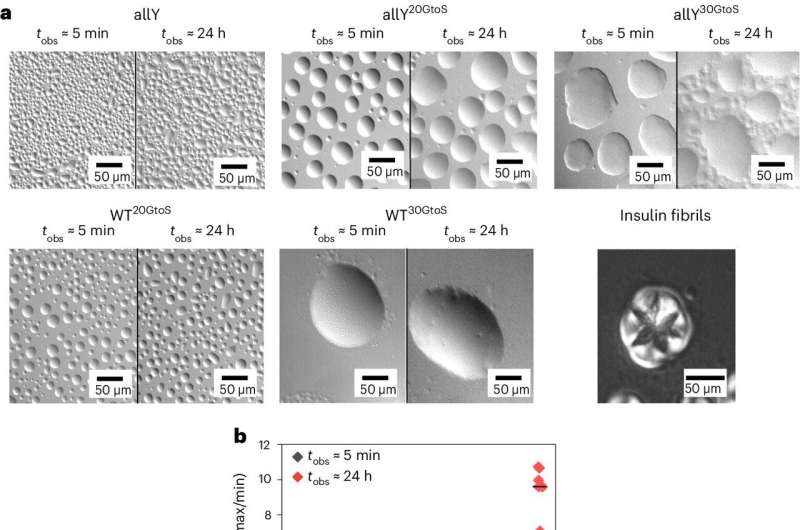This article has been reviewed according to Science X's editorial process and policies. Editors have highlighted the following attributes while ensuring the content's credibility:
fact-checked
peer-reviewed publication
trusted source
proofread
Biomolecular condensate 'molecular putty' properties found encoded in protein sequence

Biomolecular condensates are membraneless hubs of condensed proteins and nucleic acids within cells, which researchers are realizing are tied to an increasing number of cellular processes and diseases. Studies of biomolecular condensate formation have uncovered layers of complexity, including their ability to behave like a viscoelastic material. However, the molecular basis for this putty-like property was unknown.
Through a multi-institution collaboration, St. Jude Children's Research Hospital scientists examined the interaction networks within condensates to better define the rules associated with their unique material properties.
Published in Nature Physics, the results quantify the timescales associated with these interactions, explaining why condensates act like a molecular putty and how they can "age" into a viscoelastic solid more akin to a rubber ball.
"Condensates have often been described as liquid-like, but their material properties can actually vary quite a bit," explained co-corresponding author Tanja Mittag, Ph.D., Department of Structural Biology. "That depends on the sequences of the proteins within them and the lifetime of the interactions being formed."
Interaction timescales define properties of condensates
The speed at which we interact with the world influences how the world responds. Hold putty in your hand, and it will eventually flow through your fingers. Throw it at a wall, and it will bounce back.
The rules that govern this viscoelastic behavior are intrinsic to the interactions that occur within the putty, the making and breaking of which happen on a timescale encoded in the constituent molecules. This means if we interact with a material at different rates, the material will behave differently.
Biomolecular condensates act as reaction hubs to organize biomolecules in cells spatially. Their apparent abundance throughout cellular function and links to disease, particularly neurodegenerative diseases such as amyotrophic lateral sclerosis (ALS) and frontotemporal dementia, has brought with it fundamental questions that need answering.
While garnering attention for their liquid-like behavior, such as their ability to flow, exchange material and dissolve as needed, their capacity to transition to more solid-like structures has led scientists to interrogate these fundamental material properties.
Through the St. Jude Research Collaborative on the Biology and Biophysics of RNP Granules, Mittag is leading work to understand how these material properties are determined by the amino acid sequence of the proteins that form the condensate.
Current efforts build upon years of research into the "molecular grammar" of biomolecular condensates, the rules that dictate how molecules organize themselves through the process of phase separation.
Stickers-and-spacers are vital in viscoelastic crossroad
Mittag and her collaborators previously established a "stickers-and-spacers" model for predicting how proteins phase separate in work published in Science in 2020.
"What we call 'sticker' amino acids make pairwise interactions that form a network fluid," Mittag said. "Now we understand that these pairwise contacts that are forming—how stable they are and what their lifetime is—determine the viscoelastic properties of the condensates."
The arrangement of stickers (amino acids that form contacts with other stickers) and spacers (amino acids necessary for patterning and arranging stickers and interactions with water) can predict phase-separating behavior in proteins.
Now, the researchers found that whether the condensates behave as an elastic or viscous material depends on the strength of these sticker-sticker interactions.
"If we make stronger interactions, we can push their behavior more toward elastic properties. We now understand how this is encoded in the protein sequence," said Mittag.
Biomolecular condensates age into viscoelastic solids
The group further probed how condensates age, changing their material properties over time. Prior work in the field focused on how proteins within aging condensates can arrange into fibrils, repeating patterns of proteins with a high degree of order. Fibril formation is linked to neurodegenerative diseases, such as ALS and frontotemporal dementia, but, as the researchers found, it is only one route along the aging pathway.
The researchers also identified an alternative path in condensate aging. "We found that if we exchanged spacer amino acids for ones that like to interact more with water, we could get condensates to age into a solid state, but it was not crystalline. It was not fibrils. Instead, it was a viscoelastic solid," said co-first author Wade Borcherds, Ph.D., St. Jude Department of Structural Biology. "This is like putty becoming a rubber ball. They can both bounce, but one is solid, and one is not."
"Condensate research helps us understand a lot of biology that has always existed in the cell but was not understood. This work puts this kind of biology on a quantitative, physical basis instead of treating it phenomenologically," Mittag explained. "Now we know how these material properties and transitions are encoded within the protein sequence and how it really is a viscoelastic solid. That is, I think, the big breakthrough."
More information: Ibraheem Alshareedah et al, Sequence-specific interactions determine viscoelasticity and ageing dynamics of protein condensates, Nature Physics (2024). DOI: 10.1038/s41567-024-02558-1
Journal information: Nature Physics , Science
Provided by St. Jude Children's Research Hospital





















